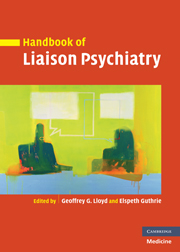Book contents
- Frontmatter
- Contents
- List of contributors
- Preface
- Part I Basic skills
- Part II Common psychiatric problems across the general hospital
- 7 Functional somatic syndromes
- 8 Alcohol problems in the general hospital
- 9 Drug misuse in medical patients
- 10 Sexual problems in medical patients
- 11 Suicide and deliberate self-harm
- 12 Delirium
- 13 Childhood experiences
- Part III Working with specific units
- Part IV Treatment
- Part V Different treatment settings
- Index
- References
11 - Suicide and deliberate self-harm
from Part II - Common psychiatric problems across the general hospital
Published online by Cambridge University Press: 10 December 2009
- Frontmatter
- Contents
- List of contributors
- Preface
- Part I Basic skills
- Part II Common psychiatric problems across the general hospital
- 7 Functional somatic syndromes
- 8 Alcohol problems in the general hospital
- 9 Drug misuse in medical patients
- 10 Sexual problems in medical patients
- 11 Suicide and deliberate self-harm
- 12 Delirium
- 13 Childhood experiences
- Part III Working with specific units
- Part IV Treatment
- Part V Different treatment settings
- Index
- References
Summary
Introduction
The aims of this chapter are threefold. First, to give an overview of the multi-faceted context in which the management of those presenting following an episode of self-harm needs to be considered. Second, to consider the link between the spectrum of suicidal behaviours and completed suicide. Finally, to consider assessment and management procedures and review the evidence for effectiveness of current practices.
Throughout this chapter the term ‘deliberate self-harm’ will be used to denote ‘an act of intentional self-poisoning or injury, irrespective of the apparent purpose of the act’. It describes a spectrum of behaviours from impulsive, superficial, self-cutting, which rarely presents to medical attention, through to premeditated and carefully planned suicide attempts which, for some reason, have not resulted in death. Whilst there is controversy concerning this definition (Van Heeringen 2001), it allows for the inclusion of the full range of self-harming behaviours, without drawing arbitrary distinctions based on perceived intent, which is often far from clear.
Suicide, as a term, appears easier to define, namely as ‘a self-destructive behaviour with a fatal outcome’. It is classified within the International Classification of Diseases (ICD) as codes E950–959. However, major differences exist in the process of determining death, both within and between countries (Neeleman et al. 1997) and therefore cross-cultural epidemiological findings need to be considered with caution.
Epidemiology
Suicide
Despite the variations in the categorization of suicide, these can only in part explain the wide variations in suicide rates across countries and over time.
Keywords
- Type
- Chapter
- Information
- Handbook of Liaison Psychiatry , pp. 245 - 269Publisher: Cambridge University PressPrint publication year: 2007
References
- 1
- Cited by

